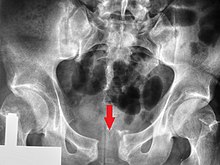| Pelvic fracture | |
|---|---|
 | |
| A pelvic X-ray showing an open book fracture | |
| Symptoms | Pelvic pain, particularly with movement[1] |
| Complications | Internal bleeding, bladder injury, vaginal trauma[2][3] |
| Types | Stable, unstable[1] |
| Causes | Falls, motor vehicle collisions, vehicle hitting a pedestrian, crush injury[2] |
| Risk factors | Osteoporosis[1] |
| Diagnostic method | Based on symptoms, confirmed by X-rays or CT scan[1] |
| Differential diagnosis | Femur fracture, vertebral fracture, low back pain[4] |
| Treatment | Bleeding control (pelvic binder, angiographic embolization, preperitoneal packing), fluid replacement[2] |
| Medication | Pain medication[1] |
| Prognosis | Stable: Good[1] Unstable: Risk of death ~15%[2] |
| Frequency | 3% of adult fractures[1] |
A pelvic fracture is a break of the bony structure of the pelvis.[1] This includes any break of the sacrum, hip bones (ischium, pubis, ilium), or tailbone.[1] Symptoms include pain, particularly with movement.[1] Complications may include internal bleeding, injury to the bladder, or vaginal trauma.[2][3]
Common causes include falls, motor vehicle collisions, a vehicle hitting a pedestrian, or a direct crush injury.[2] In younger people significant trauma is typically required while in older people less significant trauma can result in a fracture.[1] They are divided into two types: stable and unstable.[1] Unstable fractures are further divided into anterior posterior compression, lateral compression, vertical shear, and combined mechanism fractures.[2][1] Diagnosis is suspected based on symptoms and examination with confirmation by X-rays or CT scan.[1] If a person is fully awake and has no pain of the pelvis medical imaging is not needed.[2]
Emergency treatment generally follows advanced trauma life support.[2] This begins with efforts to stop bleeding and replace fluids.[2] Bleeding control may be achieved by using a pelvic binder or bed-sheet to support the pelvis.[2] Other efforts may include angiographic embolization or preperitoneal packing.[2] After stabilization, the pelvis may require surgical reconstruction.[2]
Pelvic fractures make up around 3% of adult fractures.[1] Stable fractures generally have a good outcome.[1] The risk of death with an unstable fracture is about 15%, while those who also have low blood pressure have a risk of death approaching 50%.[2][4] Unstable fractures are often associated with injuries to other parts of the body.[3]
- ^ a b c d e f g h i j k l m n o p "Pelvic Fractures". OrthoInfo - AAOS. February 2016. Retrieved 17 May 2018.
- ^ a b c d e f g h i j k l m n ATLS - Advanced Trauma Life Support - Student Course Manual (10 ed.). American College of Surgeons. 2018. pp. 89, 96–97. ISBN 9780996826235.
- ^ a b c Peitzman, Andrew B.; Rhodes, Michael; Schwab, C. William (2008). The Trauma Manual: Trauma and Acute Care Surgery. Lippincott Williams & Wilkins. p. 322. ISBN 9780781762755.
- ^ a b Walls, Ron; Hockberger, Robert; Gausche-Hill, Marianne (2017). Rosen's Emergency Medicine - Concepts and Clinical Practice E-Book. Elsevier Health Sciences. pp. 577, 588. ISBN 9780323390163.